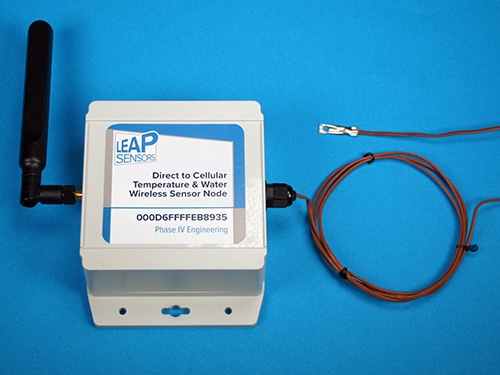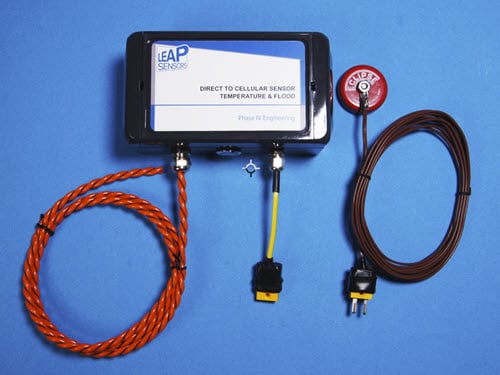-
 This wireless sensor communicates via a cellular transmission for remote temperature & flood monitoring. Sensor transceiver node combines standard mini k-type thermocouple connector for temperature sensing (wide temperature range) and a water sensor for flood detection or to detect water inside an enclosure. No gateway required – ideal for remote locations where standard sensors won’t work. Sensor node transmits via cellular link directly to cloud-based user interface. Receive alerts by email or text. “Practically battery-free”™ - Long battery life (up to 10 years, depending on application & transmission interval). Customize to your specific needs, including options to transmit only when designated thresholds are exceeded. Part of the breakthrough Leap Sensors system. Build your quote here:
This wireless sensor communicates via a cellular transmission for remote temperature & flood monitoring. Sensor transceiver node combines standard mini k-type thermocouple connector for temperature sensing (wide temperature range) and a water sensor for flood detection or to detect water inside an enclosure. No gateway required – ideal for remote locations where standard sensors won’t work. Sensor node transmits via cellular link directly to cloud-based user interface. Receive alerts by email or text. “Practically battery-free”™ - Long battery life (up to 10 years, depending on application & transmission interval). Customize to your specific needs, including options to transmit only when designated thresholds are exceeded. Part of the breakthrough Leap Sensors system. Build your quote here: -
 This wireless sensor communicates via a cellular transmission for remote temperature & flood monitoring. The internal antenna keeps the transceiver node small and resistant to damage. Sensor transceiver node combines standard mini k-type thermocouple connector for temperature sensing (wide temperature range) and a water sensor for flood detection. No gateway required – ideal for remote locations where standard sensors won’t work. Sensor node transmits via cellular link directly to cloud-based user interface. Receive alerts by email or text. “Practically battery-free”™ - Long battery life (up to 10 years, depending on application & transmission interval). Customize to your specific needs, including options to transmit only when designated thresholds are exceeded. Part of the breakthrough Leap Sensors system. Build your quote here:
This wireless sensor communicates via a cellular transmission for remote temperature & flood monitoring. The internal antenna keeps the transceiver node small and resistant to damage. Sensor transceiver node combines standard mini k-type thermocouple connector for temperature sensing (wide temperature range) and a water sensor for flood detection. No gateway required – ideal for remote locations where standard sensors won’t work. Sensor node transmits via cellular link directly to cloud-based user interface. Receive alerts by email or text. “Practically battery-free”™ - Long battery life (up to 10 years, depending on application & transmission interval). Customize to your specific needs, including options to transmit only when designated thresholds are exceeded. Part of the breakthrough Leap Sensors system. Build your quote here:
Cellular Connected Sensors
Direct to Cellular Wireless Sensors
“Deploy Anywhere” Wireless Sensors – Ideal for Remote Monitoring
These wireless sensors connect directly to the cellular network and have no gateway. They can be deployed anywhere with cellular coverage but have higher battery usage.
Direct to cellular wireless temperature sensors and flood sensors are useful in many applications.
Other sensor types coming soon – contact us to learn more.
Phase IV Engineering, Inc.
2820 Wilderness Place, Unit C
Boulder, Colorado 80301, USA
Sales and Application Engineering: (720) 943-3944
RFID (only) Sensor Sales and Engineering: (720) 541-2086
All Other Inquiries Toll Free (North America only): 1-866-608-6168
Local & International: (303) 443-6611
© 2014-2024 Phase IV Engineering Inc. | All Rights Reserved | Privacy Policy | Website by EOB Consulting Inc.
Our website uses cookies and third party services. By continuing to use it, you agree to their use. Learn more.
Ok